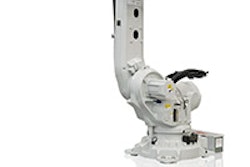The EX1 circuit board printer is latest Kickstarter campaign with “3D printing” in its headline to grip the imagination and, more importantly, financial support of more than 230 backers.
View: Kickstarter of the Week: How to Print Circuit Boards as Easy as a Photo
With 22 days remaining in the campaign, Brisbane, Australia-based Cartesian Co. has raised more than $115,000, far surpassing its original $30,000 goal, to fund a 3D circuit board printer capable of printing on anything from plastic and wood, to fabric and paper.
Cofounder and electrical engineer Ariel Briner came up with the concept while he was a student at the University of Queensland. According to John Scott, EX1 cofounder, mechanical engineer, and Ariel’s friend, Briner was working on a team project with a semester deadline fast approaching, and his group had yet to build a working prototype.
Briner was etching a board using the old PCB toner transfer method when he became fed and insisted on finding a better way. After tireless research, his hard work has turned into to a high-yield crowdfunding campaign, but not without the initial push from a startup incubator.
Established by the Queensland Government in 2000 to support early stage, high-tech companies through the first few years of development, Scott credits ilab as a large reason for the EX1’s success.
“We applied to ilab not really thinking that much of it,” Scott recalls. “When we put together the prototype, we pitched it at the ilab pitching session, the response was really positive, and we got in. It led to a year of furious development, and I’m amazed at the stage that we’re at now.”
Since 2000 ilab has incubated more than 100 start-up companies and helped raise more than $70 million in grants and investments to fund future growth. The lab is responsible for creating approximately 400 jobs in the tech sector.
With a little more funding, the Cartesian crew was able to develop the product, and gained access to the lab’s business and strategy mentors. The company had to give up some equity (percentage undisclosed), but as Scott sees it, “[EX1] would not be at the stage that we are at without ilab.”
“You’re in this environment where building stuff is the most important thing,” Scott adds. “Being [here] is really motivating. When you’re a hobbyist on your own, it’s very difficult to motivate yourself to work on a project.”
Difficulties with Inkjet Parts
The printer uses inkjet print heads that first print a layer of silver nitrate followed by a layer of ascorbic acid. It’s an old reduction reaction that yields elemental silver.
Specifying the inkjet parts proved to be one of the most significant challenges, because it was difficult to find parts that were compatible with silver nitrate and ascorbic acid. The team had issues with clogging print heads, as well as being able to drive the heads electrically.
“Seventy percent of our time was spent on the cartridges,” Scott says. “We went through a bunch of different inkjet cartridges. It’s obviously not possible for us to make our own, so we had to use something that was off the shelf.”
After much experimentation, the team specified HP inkjet cartridges.
The HP cartridges not only solved the chemical compatibility issues, but it also worked for previous issues the prototype had with pulsing. Each cartridge nozzle needs to be pulsed to fire, and quickly. It’s a lot of data that needs to be sent to the print head, and while printing companies have nailed down the printing algorithm after decades of development, Scott notes that they are still not printing as fast as possible – though he is confident that speed won’t be an issue in subsequent generations.
Print speeds vary based on the difficulty of the job, but for an average-sized, single-sided board, it takes about 30 minutes to print a 5 x 5 cm area. “It also depends on the conductivity you need,” adds Scott. “You can lay down as much silver as you want for your application.”
For Hobbyists & Engineering Professionals (Soon)
Initially, the EX1 has been marketed to hobbyists. The current version has a resolution of 600 DPI, and it has been tested to reliably make tracks/pads down to SOIC components (1.27 mm pin spacing).
“We weren’t really sure how useful it would be to professionals, but we are confident that we can get the resolution better,” says Scott.
According to Scott, nothing similar exist in the hobbyist marketplace, but he still had no idea what sort of response the EX1 would receive.
“It is a little bit intimidating, but we were careful to design everything using commercial off-the-shelf components, so we could make it proper in small volumes and increase to larger volumes,” he says. “We were concerned about a handling a huge number of orders, but we were careful about the design to make sure everything was completely modular.”
EX1 strives to make circuit board printing as simple as importing an image and pushing print, making prototyping electronics as easy as 3D printing. By quadrupling crowdfunding expectations in less than a week, they just might be on to something.
For more information, including backer incentives and further EX1 specifications, visit Kickstarter.com – and be sure to check out the FAQ at the bottom of the page.























